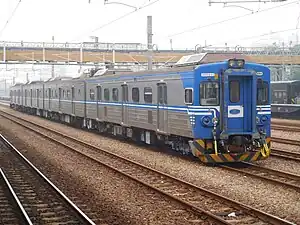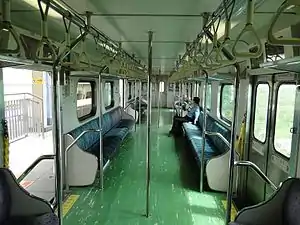| EMU600 series | |
|---|---|
 An EMU600 at Changhua Station | |
 Interior of an EMU600 train | |
| In service | 2002–present |
| Manufacturer | KOROS (now Hyundai Rotem), Tang Eng Iron Works |
| Constructed | 2001-2002 |
| Entered service | 11 October 2002 |
| Number built | 56 |
| Number in service | 56 (as of 2015)[1] |
| Formation | EMC-EP-ET-EM |
| Specifications | |
| Train length | 20,300 mm (66 ft 7+3⁄16 in) |
| Width | 2,853 mm (9 ft 4+5⁄16 in) |
| Height | 4,234 mm (13 ft 10+11⁄16 in) |
| Entry | Low floor |
| Doors | 3 per side per car |
| Weight |
|
| Traction system | IGBT–VVVF (Toshiba) |
| Traction motors | 3-phase AC induction motor (Toshiba) |
| Power output | 1,920 kW (2,570 hp) |
| Tractive effort | 194.2 kN |
| Electric system(s) | 25 kV 60 Hz AC (nominal) from overhead catenary |
| Current collector(s) | Pantograph |
| Bogies | Alstom |
| Braking system(s) | Knorr-Bremse Kbr X1 |
| Multiple working | Within type With EMU500 |
The EMU600 series is a series of electric multiple unit passenger trains operated by Taiwan Railways Administration (TRA). The trains are built as local trains and are used throughout the island’s rail network.
History
With the electrification of the Yilan line and the North-link line in the early 2000s, the TRA faced a shortage of electric passenger trains. Therefore, in 1999, the TRA contracted South Korean manufacturer KOROS to build 56 more cars divided into 14 trainsets. The first two trainsets were shipped to Taiwan on October 3, 2000. When KOROS merged with other companies in 2002 to form Hyundai Rotem, the new company continued to produce the trains. The last two trainsets (numbered 613 and 614) were produced in Taiwan by Tang Eng Iron Works. The trains entered service on 11 October 2002.[2]
Features
The EMU600 series runs in four-car units in the following order: a motorized car with the cab (EMC), an unmotorized car with a pantograph (EP), an unmotorized car (ET), and a motorized car (EM). On the outside, the EMU600 series shares many similarities with the EMU500 series, which was manufactured six years earlier. Both exteriors are made of stainless steel and have very similar liveries. However, unlike its predecessor, the traction system on the EMU600 series uses a insulated-gate bipolar transistor (IGBT) made by Toshiba instead of a gate turn-off thyristor (GTO) on the EMU500 series.[2]
Similar to other local trains, the EMU600 series is fitted with cloth seats running parallel to the center aisle. In 2010, an LED display was installed above the doors.[2] The cars originally had one step at each door; this was removed beginning in 2017 by raising platforms and remodeling the interior to turn the trains into a low floor layout for accessibility. As of November 2019, 70% of EMU600 trains have been reconfigured.[3][4]
References
- ↑ "臺鐵整體購置及汰換車輛計畫(104~113年)" (in Chinese (Taiwan)). Taiwan Railways Administration. 2015. p. 12. Retrieved 6 November 2020.
- 1 2 3 "EMU600型通勤電聯車". Train Collection (in Chinese (Taiwan)). Retrieved 6 November 2020.
- ↑ 王苡嫣 (3 February 2017). "上下車更方便 台鐵車廂月台無階化預計109年完工" (in Chinese (Taiwan)). Now News. Retrieved 3 May 2020.
- ↑ 曹悅華 (6 November 2020). "太魯閣號無階化昨動工 鐵道迷捕捉歷史性一刻" (in Chinese (Taiwan)). United Daily News. Retrieved 6 November 2020.